The Old Countess, the Geraldine knight and the lady antiquarian: a conspiracy theory revisited
Published in Early Modern History (1500–1700), Features, Issue 3 May/June2013, Volume 21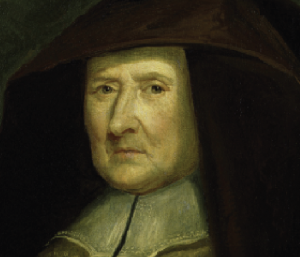
‘Catherine, Countesse of Desmonde. As she appeared at ye Court of our Sovereign Lord, King James, in thys present AD. 1614, and in ye 140th Yeare of her Age. Thither She came from Bristol, to seek Relief, ye House of Desmond having been ruined by Attainder. She was married in ye Reigne of King Edward IV and in ye course of her long Pilgrimage, renewed her Teeth Twice. Her principal residence is at Inchiquin, in Munster, whither she undauntedlye proposeth (her Purpose accomplished) incontinentlie to return. Laus Deo.’ (National Portrait Gallery, London)
In the nineteenth century, Katherine Fitzgerald, the ‘Old’ Countess of Desmond, was one of the most familiar characters from early modern Ireland. Her story was romantic and remarkable. Assumed to have been born in the 1460s, in Dromana, Co. Waterford, she had, so legend went, married in Edward IV’s reign, and had even danced at court with the future Richard III. Her husband was Thomas ‘the bald’ Fitzgerald, who in 1529, when in his seventies, became 11th earl of Desmond, and with whom she had a daughter. When Thomas died in 1534, Katherine retired to the curious medieval castle at Inchiquin in east Cork, near Youghal, where she lived until her death in 1604 or 1614, though on at least one occasion she supposedly departed to petition Elizabeth I or James I, her reduced means forcing her to walk from Bristol to London, pulling her aged daughter in a cart.
Thus it was claimed that she lived until at least the age of 140 (or possibly 162!), remaining extraordinarily healthy in her later years: she had allegedly grown at least one new set of teeth, she regularly walked to Youghal, and she met her death when she fell out of a cherry or nut tree that she had climbed to pick the fruit, some sources adding the detail that the tree had been planted by Sir Walter Raleigh. ‘What a frisky old girl!’, exclaimed Thomas Moore.
The legend dissected
Nineteenth-century biographers like Louisa Stuart Costello, who included a garbled account of Countess Katherine in her Memoirs of eminent Englishwomen (1844), kept her in the public eye. In the 1850s and ’60s, writers seeking to establish the authenticity of several portraits purporting to represent her began the task of separating the obviously exaggerated elements of her story from verifiable facts. The process whereby second- and third-hand reports had become accepted as truth was uncovered: for example, the story of Katherine walking to London was found to have derived from confusion with another dowager countess of Desmond, Eleanor, widow of the rebel 14th earl, who travelled more than once (though not on foot!) to petition Elizabeth I.
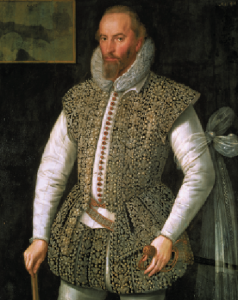
Above: Sir Walter Raleigh—provided one of the first ‘public’ notices of the countess’s great feat of longevity. In his History of the world (1614) he claimed: ‘I myself knew the old Countess of Desmond, of Inchiquin in Munster, who lived in the year 1589, and many years since; who was married in Edward the Fourth’s time, and held her joynture from all the Earles of Desmond since then; and that this is true all the Noblemen and Gentlemen of Munster can witnesse’. (Marriage settlements in wealthier families often specified a jointure, usually a piece of property that would act as a residence and allow a widow to support herself until her own demise, or she would be entitled to dower, a portion of her husband’s property.) Raleigh was the only person who claimed in print actually to have met the dowager countess. Fynes Moryson, Francis Bacon and other eminent English writers were later to cement her reputation, each adding hearsay evidence to round out the picture of her life. (National Gallery of Ireland)
The most influential contributors to the debate were John Gough Nichols and Richard Sainthill. Nichols discovered that Thomas ‘the bald’ Fitzgerald’s ‘previous’ wife was still alive in 1505, lessening the likelihood that the countess could have married him earlier. Both men drew attention to leases from the 1580s and ’90s mentioning the countess, and contended that none of the portraits could have been made from life. Nevertheless, Sainthill still believed it possible that the countess had lived to a great age. He therefore glossed over several improbabilities, tying himself in knots attempting to fit together her supposed birth in the 1460s, her post-1505 marriage and the birth of her daughter, even seriously considering the possibility that she had given birth in her late 40s or 50s.
The Sainthill interpretation has had an enduring impact, and still tends to be the main source for writers discussing the countess. But critiques were soon mounting. Academic interest in charting the limits of human longevity grew in the nineteenth century, as claims of remarkable lifespans were increasingly subjected to more rigorous scrutiny. In 1873 W.J. Thoms published Human longevity: its facts and fictions, in which he argued that few claims of centenarianism (individuals living beyond the age of 100) were verifiable. He demolished the idea that the countess had lived to the age of 140, dismissing evidence for her early years as hearsay and contending that she could have been no older than 100 at her death.
A similar attempt to foreshorten the countess’s lifespan was made recently by Anthony McCormack, who suggested that the countess could conceivably have been born as late as 1514 and could have married as a teenager, giving a comfortably plausible age at death of about 90. It actually seems likely that the marriage occurred in the late 1520s: in 1529 Earl Thomas ‘the bald’ Fitzgerald made an agreement with John Fitzgerald, lord of the Decies, Katherine’s father, granting him lands in return for support in the anticipated contest over the earldom between Thomas’s son and alternative claimants. Shortly afterwards, Katherine was granted the lands at Inchiquin and an annual stipend ‘as . . . the other countesses have been wont to receive . . . to hold during life’.
The lady antiquarian
So the tendency has been to rationalise the Old Countess’s life by cutting the earlier years. But should we also be shaving it from the other end? George Carew’s note that her death occurred in 1604 is generally accepted, but he provided no independent source for this information. One dissenting view has, however, been ignored. In 1881 Mary Agnes Hickson, a Kerry-born ‘lady antiquarian’, drawing on her knowledge of the history of the Munster Fitzgeralds, published a detailed article in The Reliquary in which she argued that the Old Countess had died well before 1604. Furthermore, she claimed that Sir Walter Raleigh had been the victim of a crafty fraud designed by Sir John FitzEdmund Fitzgerald, member of a minor branch of the house of Desmond, to keep the lands at Inchiquin under his own control.
The Geraldine knight
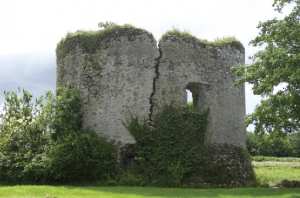
The ruin of Inchiquin Castle today, near Youghal, Co. Cork.
Sir John FitzEdmund Fitzgerald was aggressively unscrupulous in increasing his own landholdings at the expense of his neighbours and the church. He started out as a Desmond supporter, even getting involved in a stunt in the 1585–6 parliament designed to stop proceedings to confiscate the lands of the rebel 14th earl, when he dramatically revealed a document that seemed to suggest that the earl did not personally own his lands at the time of the rebellion and thus they could not legally be seized.
When the commissioners charged with surveying Desmond’s lands arrived in Youghal in 1586, two more unusual documents emerged, being officially enrolled in Dublin in November by John Synnott (possibly a Wexford merchant). Dating from August 1575, the first was a transfer by the countess (‘sealed, but not signed, by her’—Hickson claimed that she might even have been dead by this time) of the castle and dower lands of Inchiquin to the earl of Desmond, and the other was a transfer by the earl (again sealed but not signed) of the same lands to Maurice Shehan, his secretary, and David Roche, to the use of ‘John Synnott his heirs and assigns . . . free from all rents or exactions or anie dutie or demande thereunto’ for 31 years.
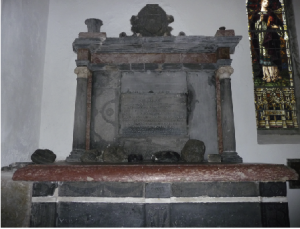
The tomb of John FitzEdmund Fitzgerald and his son, Cloyne Cathedral, Co. Cork.
Hickson suggested that Synnott and his associates knew that such a grant would likely be ignored as a fraudulent attempt to save the lands from seizure, but their ultimate aim was to put on record the countess’s prior claim to them and to divert that claim to a supporter of FitzEdmund Fitzgerald’s. In all this she traced a trail back to Fitzgerald: both Maurice Shehan and John Synnott were also involved in the previously mentioned attempts to preserve Desmond’s lands, and Shehan was a kinsman of Matthew Shehan, the ‘Protestant’ bishop who had transferred the church lands of Cloyne to Fitzgerald’s possession for a minuscule annual rent.
This is an attractive theory, based on a deep knowledge of the documentation and, more importantly, on an instinctive and unromantic understanding of the period and of individuals like John FitzEdmund Fitzgerald. It seems entirely logical that Fitzgerald might have been interested in the stout castle at Inchiquin. It was a former Fitzgerald possession close to his own territory and situated on the bank of a marshy river which enters the sea a few miles south-west of Youghal, making it a potential alternative landing point for goods and people.
Problems with Hickson’s conspiracy theory
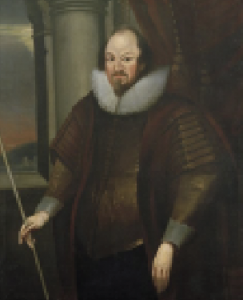
Richard Boyle—Hickson noted the curious coincidence that the ancient lady had supposedly died in exactly the year that the lands at Inchiquin passed from the financially and politically ruined Raleigh to Richard Boyle, later earl of Cork, and just before the strange 1575 31-year lease to John Synnott was due to run out. (Bridgeman Art Library)
Whatever the intentions behind the document, as part of the Munster Plantation a large section of the Desmond patrimony officially passed to Sir Walter Raleigh, though he would have been expected to observe the countess’s jointure rights to Inchiquin. Here Hickson’s conspiracy theory kicks in again. Despite his own account of having known that Old Countess, she suggests that Raleigh may never have met her at all, and that another elderly lady may have been recruited to impersonate her. Raleigh was a busy man, with interests in the Americas and England as well as Ireland, and seems to have spent very little time in Youghal, despite local legends about him living there ‘for many years’, smoking Ireland’s first tobacco and cultivating its first potatoes and cherries. He may have presented a likely target for fraud but it is unlikely that he was fooled.
Notwithstanding the devastation wreaked during the Desmond rebellion, east Cork became relatively busy thereafter, as Raleigh and his associates proceeded with plans to exploit its natural resources. It does not seem plausible, at least in the period before the outbreak of the Nine Years War in 1594, that rumours of a fake or deceased countess would not have reached Raleigh or his friends. In the early 1590s Raleigh was making leases of part of the countess’s lands that made provision for higher rents to be paid after her death, which seems to have been expected to be imminent. Hickson’s suggestion that this gave the leaseholders a reason to collude with the fraud is also somewhat unconvincing.
Furthermore, Hickson made a key mistake, based on the mistranscription of records by others. She took up the idea that in 1591 ‘the castle, barony and manor of Inchequyne’ were leased to a Robert Sawle, assuming him to be of the Sall family of Tipperary and therefore a Desmond supporter and a FitzEdmund Fitzgerald crony. The leaseholder was actually Robert Mawle, Raleigh’s long-time associate and land agent.
At the very least, Hickson’s work reminds us, first, always to double-check other people’s representations of the records, and, second, given the corruption prevalent in sixteenth-century Ireland, always to question whether documents are what they purport to be. And though it is impossible to accept the most substantial part of her theory, that is not to say that it is wrong in its entirety. Whether or not the countess had died by 1575, there were certainly some machinations concealed behind the peculiar documents of that year whereby Inchiquin was transferred first to Desmond and then to the elusive John Synnott. Likewise, if the countess was alive in 1589, when Raleigh believed he had met her, it seems certain that she was dead before Carew’s date of 1604. Hickson noted the curious coincidence that the ancient lady had supposedly died in exactly the year that the lands at Inchiquin passed from the financially and politically ruined Raleigh to Richard Boyle, later earl of Cork, and just before the strange 1575 31-year lease to John Synnott was due to run out. HI
Clodagh Tait lectures in history at Mary Immaculate College, University of Limerick.
Further reading
M.A. Hickson, ‘The Old Countess of Desmond: a new solution of an old puzzle’, Reliquary 22 (1881).
A.M. McCormack, ‘Fitzgerald, Katherine, countess of Desmond (d. 1604)’, Oxford Dictionary of National Biography (Oxford, 2004).
P. MacCotter, ‘The Geraldine clerical lineages of Imokilly and Sir John Fitzedmund of Cloyne’, in D. Edwards (ed.), Regions and rulers in Ireland, 1100–1650: essays for Kenneth Nicholls (Dublin, 2004), 54–77.
















